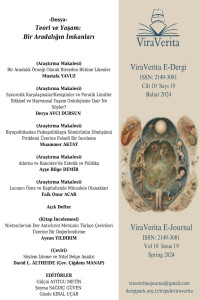Articles
Açık Defter (Makaleler)
Açık Defter (Çeviri)
Issue Editorial Board



Aim & Scope
ViraVerita International Interdisciplinary Encounters Journal is a peer-reviewed academic journal internationally indexed (Philosopher’s Index and Index Copernicus) and aims to publish genuine scientific articles in the fields of philosophy, psychology, law, sociology, anthropology, communication, history, political sciences and international relations.
ViraVerita Peer-reviewed E-journal is open to contributions from various fields such as philosophy, psychology, law, political science, sociology, international relations, anthropology, sociology, history and so on. We would just as well be glad to allocate a space for your off-topic articles and translations.
Author Guidelines
1. Manuscripts should be written in MS Word format, Calibri typeface and 1,5 line spacing. Type size should be 12 in the main text and 10 in the other parts (endnote, abstract, bibliography, table etc.). The endnote number and inverted comma should follow punctuation marks. Titles should be minuscule except their first letters and not be enumerated. Paragraph spacing should not be distinct from line spacing.
2. Titles should be utmost quaternary levels. These titles should be written in accordance their levels as follows:
First Level Sub-title: Xxxxxxxx Xxxxx (First letters are capital and bold)
Second Level Sub-title: Xxxxxx Xxxxxx (First letters are capital and italics)
Third Level Sub-title: i) Xxxxxx (Begins with the signs of i, ii, iii etc.)
Fourth Level Sub-title: - Xxxxxx (Begins with hyphen)
Sub-titles should be written in 12-type size and next to left. First paragraphs following these titles should also be next to left. There should be two-line spacing before titles and one-line spacing between title and paragraph. First paragraphs following the other level sub-titles should start with the same indentation. For these levels, there should be one-line spacing before the sub-title and between the title and the paragraph.
3. Quotes should be in 12 and Calibri typeface. If the quote is less than 40 words you should use double quotation marks around the exact words and if it is more than 40 words it should be a block quote indented like a paragraph double spaced, with no quotation marks.
4. Notes should be endnotes and as short and as few as possible.
5. Centuries and digits should be written in words (twentieth century, three), numbers should be written in digits.
Reference Rules
Manuscripts should be ordered according to the APA 6th style.
Examples of In-text citation for APA 6th style
• When referring to an entire work
Kuçuradi (2007)…
(Kuçuradi, 2007)
Two authors:
Charlesworth and Chinkin (2000)…
(Charlesworth and Chinkin, 2000)
• If the reference is a direct quote:
Single Author:
(Kuçuradi, 2007, p. 14)
Two authors:
(Charlesworth and Chinkin, 2000, p. 213)
Three, four or five authors:
For the first cite, all names should be listed.
Kuçuradi, Leach, and Chinkin (2010) …
(Kuçuradi, Leach, & Chinkin, 2010).
Further cites can be shorted to the first author’s name followed by et al.:
Kuçuradi et al. (2020) …
(Kuçuradi et al., 2020).
• Edited Books:
(ed (s). Edwards, 2012)
• Secondary sources:
(Foucault, as cited in Bernauer, 2005)
According to Foucault (1991) … (as cited in Bernauer, 2005)
• If you are referring more than one source at the end of the sentence, those sources should be in alphabetical order and in parenthesis.
... (Dalbert, 1997; Kleft & Dobson, 1990; Smith et al., 1980; Winson, George & Zeng, 1986).
• Citing authors with multiple works from one year:
(Mouffe, 2008a)
(Mouffe, 2008b)
• Reports, brochures and institutional publications:
According to the report dated 2013 (SPK, 2013) …
• If the author or editor is unknown, the title or the first three words of the title of the work should be used instead of author’s name. If it is the title of a book or periodical it should be italicized.
(“Religion in Roman Empire”, 2001, p. 121)
(Gezi Parkı Olayları, 2013)
• If the date is unknown
(Erdem, n.d., p. 67)
• Citing an unknown author from an online source should be in endnotes.
Title of the document (if there is not one then the date), webpage, date accessed: Day.Month.Year
• Citing a personal interview
(Personal interview, 13.07.2013)
• Tables should be started from a newpage and each table should be given in different pages. Rules for tables should also be in accordance with APA 6th Style. Number and title of the table should be above the table and the first letters of the title should be capital.
Reference List
Reference list should also be ordered according to the APA 6th style. It should be ordered alphabetically by author and then chronologically by year of publication. If there are multiple sources with the same authors and years of publication, name of the author should be written for each of these sources and then ordered chronologically.
An example of a reference list for APA 6th style:
Estrich, S. (1987). Real rape: How the legal system victimizes women who says no. Cambridge: Harvard University Press.
Deleuze, G., & Guattari, F. (2004). A thousand plateaus: Capitalism and schizophrenia. London: Continuum.
Warshaw, J., Thomas, B., & Stock, M. (2016). Principles of ethics for sociology students. London: Routledge.
Johnson, B., Castels, K., Brown, M., Scarce, T., Lane, J., & Marcel, T. (Eds.). (2007). Male Rape revisited. Oxford: Oxford University Press.
Rubin, G. (1977). The traffic in women: Notes on the political economy of sex. In L. Nicholson (ed.), The second wave: A reader in feminist theory. London: Routledge.
McNay, L. (1999). Gender, habitus and the field: Pierre Bourdieu and the limits of reflexivity. Theory Culture Society, 16(1), 95 – 117.
Jameson, F. (2003). The end of temporality, Critical Inquiry, 29 (4), 695-719. Doi: 10.1086/377726
For more please check apastyle.apa.org.
Ethical Principles and Publication Policy
1. Aim and Scope: ViraVerita International Interdisciplinary Encounters Journal is a peer-reviewed academic journal internationally indexed (Philosopher’s Index and Index Copernicus) and aims to publish genuine scientific articles in the fields of philosophy, psychology, law, sociology, anthropology, communication, history, political sciences and international relations.
2. Medium of Publishing: ViraVerita is an electronic journal. No printed version.
3. Frequency of Publication: ViraVerita is a biannual journal (Spring and Autumn). Spring volumes are published between June 1 and June 20 and Autumn volumes are published between December 1 and December 20 latest. Submissions for the Spring should be submitted by February 15 latest and submissions for the Autumn should be submitted by August 15 latest. ViraVerita invites submissions in relation to special theme issues announced for each issue but it also invites open-theme articles.
4. Content: Only research articles are accepted for the review process. The articles should not be published before, not be accepted for publication by another journal and not be sent simultaneously for the review process to another journal.
5. Publication Ethics: The scientific, ethical and legal responsibility regarding the articles belongs to the author/authors. Author(s) should consider the academic ethical principles and prepare their work obeying these principles. Articles’ authenticity check will be conducted by Turn-it-in Program.
6. Language: ViraVerita accepts submissions in Turkish and English.
7. Instructions for Authors: The articles should be written in accordance with the guideline announced on this web page: https://dergipark.org.tr/en/pub/viraverita/writing-rules. The articles should be within the range of 3000-8000 words, should include abstracts in Turkish and in English between 100 and 250 words with 5 keywords indicted just below, and should have a Bibliography at the end. The articles should be prepared in accordance with the American Psychological Association (APA) 6.0 style in terms of the reference system, the format of footnotes and bibliography.
8. Submission Guideline: The articles should be submitted via the DERGİPARK online journal management system reached online at this web page: https://dergipark.org.tr/en/pub/viraverita. Whole process of article submission will be conducted by this system to which you sign in with your username and password. The author(s) name(s) and surname(s), academic title(s), affiliation(s) and contact details should be indicated at this system. The information about the author(s) should be excluded from the articles in preparation for the double-blind peer review. In addition to that, the author's name should be removed from MS Word. (To remove the author(s) information apply to File>Properties>Author).
9. Evaluation Process: The submitted articles undergo a double-blind peer-review process. The authors are not informed about the identities of the referees and the referees are not informed about the identities of the authors. The articles are taken into preliminary examination in terms of content and writing/ reference rules by the editorial team before the double-blind peer review. Articles that are not prepared in accordance with content and writing/reference rules will not be accepted for the peer review process and will be sent back to the author(s) with the suggestion to revise it or will be rejected directly. The articles evaluated as sufficient for the blind-peer review process will be evaluated by two referees. If there is one acceptance and one rejection, the article will be sent to a third referee. Every evaluated paper should get the approval of two referees. In line with the opinions and suggestions of the third referee, the editor acts in accordance with his/her own authority. The double-blind peer-review process takes around two months. If the referee(s) asks for revisions, the author will be informed about it and the article should be revised in two weeks and sent back to the editors.
10. Publication Rights: All rights of published works belong to ViraVerita International Interdisciplinary Encounters Journal and there is no royalty payment. To publish all or parts of the articles published in ViraVerita, one should ask for permission but the citations with references are allowed. In terms of the articles published in ViraVerita, the responsibility belongs to the author(s).
Price Policy
Processing and publication are free of charge with the journal. There is no article processing charges or submission fees for any submitted or accepted articles.
Open Access Statement:
This is an open-access journal which means that all content is freely available without charge to the user or his/her institution. Users are allowed to read, download, copy, distribute, print, search, or link to the full texts of the articles, or use them for any other lawful purpose, without asking prior permission from the publisher or the author. This is in accordance with the BOAI definition of open access.
ViraVerita E-Journal is licensed under a Creative Commons Attribution-NonCommercial 4.0 International License (CC BY-NC).






